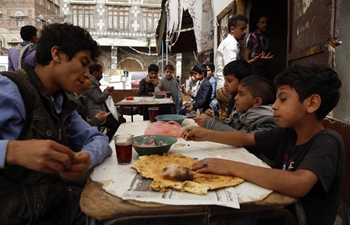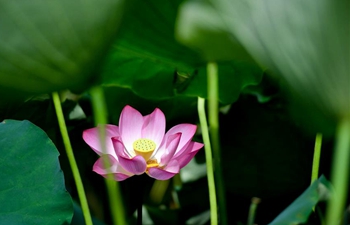TIANJIN, July 22 (Xinhua) -- For most Chinese, dough is only be used to make noodles, dumplings and steamed buns. This is not the case for 71-year-old Wang Di who can turn dough into lifelike figurines such as ancient beauties.
Wang, a folk artist of dough figurines, mixes wheat flour, glutinous rice flour and preservatives in a container, slowly adds some water and then steams the dough for about 20 to 25 minutes.
"Well begun, half done. It usually takes me two to three hours to finish the preparation work. The proportion of each ingredient should be accurate," Wang said as she pulled out a lump of thumb-sized dough to check whether it was elastic or not.
To make a figurine's head, Wang sprinkled a little bit flesh-colored pigment into the dough and kneaded into a small ball. She used a piece of a plastic knife to carve and mold the outline of chin, nose and eyes in just several minutes.
"I will imagine the expression of a figurine in my mind and depict it on the dough until I am satisfied," Wang said, connecting the figurine's body parts together and dressing the lady in her hands with dough-made Qipao, a classic one-piece and tight-fitting Chinese dress for women.
So far, she has created female figurines ranging from classic fairies and characters in famous novels to ethnic genres with exotic styles. Some of them look smart and lively, while some are quiet and at ease.
Wang, born in 1948 in northern China's Tianjin Municipality, is an inheritor of the intangible cultural heritage of dough figurine making, which can be traced back to the Han Dynasty (202 B.C.-220 A.D.)
People first made dough food, shaped like butterflies and lotus flowers, to celebrate traditional festivals. As time went on, it became a traditional handicraft art.
When she was a little girl, Wang was fond of painting. "I loved to copy portraits of ladies from comic books, and I kept on this hobby during my school days," Wang said.
In her 30s, Wang found another form to show the beauty of Chinese ladies -- dough figurines. Since she worked in a local medical college drawing and making models of human bodies, Wang quickly grasped the skills of this art.
She began to look for inspiration from Chinese classical legends, myths and novels such as "A Dream of Red Mansions."
A majority of figurines Wang has created are cozy and optimistic. "I hope to keep myself delighted, and meanwhile, bring happiness and tranquility to my audience," she said.
Moreover, she visited various related exhibitions to absorb more experience. "When I would learn about an exhibition being held in Beijing, I would rush there early in the morning," Wang said, adding that she felt so happy to see a dough figurine exhibition at that time.
In 1988, Wang held a small solo exhibition, and to her surprise, she received high praise from many experts. "I gained more confidence since then."
Wang was devoted to the dough figurine and soon made her name in the world. She has visited over 20 countries and regions to spread Chinese traditional dough figurine art.
In 2000, during her visit to Texas in the United States, Wang taught more than 1,000 U.S. students to make dough figurines.
"They loved it and showed great enthusiasm. Some little kids pushed their way through the crowd to follow my teaching steps," Wang said. Some foreigners also sent her emails and looked forward to visiting China to learn this art.
"Each of my works contains a story, and each figurine has its own soul," Wang said, adding that the art of dough figurine originates from life. "Being able to learn, inherit and spread this art, I feel honored and proud."

















